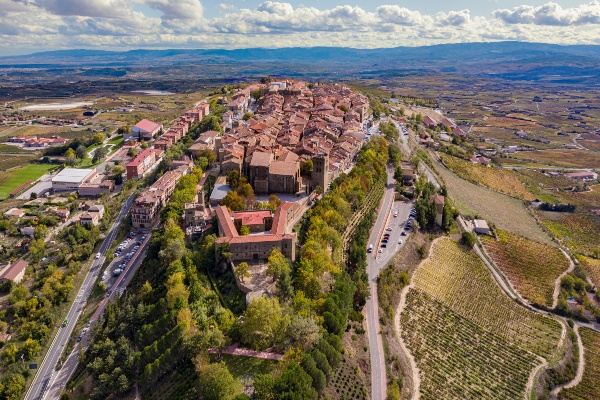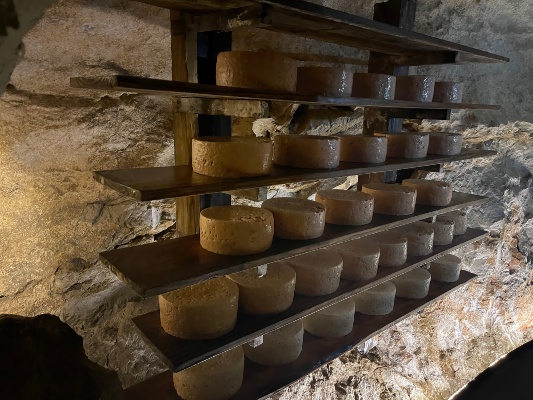A food tour through Northern Spain

Six nights on the ground was long enough to get a seductive taste of what Northern Spain has to offer the food-focused traveller, discovered Anna King Shahab.
With diverse geography and climate, coasts on the Mediterranean and Atlantic, as well as a history that includes Moor and Celtic influences, the cuisine of Northern Spain is rich and varied. The people of Northern Spain expect nothing less than excellent quality when it comes to food, and yet it’s always approachable and affordable. Best of all, eating and drinking is a very social affair here; mealtimes are happy times for both locals and visitors.
Landing in Barcelona at 7am, we hit the ground running. Having flown Cathay Pacific from Auckland, we’ve wasted no time getting here: with daily flights Auckland to Hong Kong and then on to Barcelona, the short transit and very comfy new A350-900 ensured we arrived in Barcelona well rested and ready to explore. We were booked into an Intrepid Travel ‘Real Food Adventure’ and after meeting our Spanish guide Laura, we set out to explore Barcelona and beyond. Here are some of the highlights of a food-filled week in Northern Spain:
Barcelona
Our Barcelona guide Sarah Stothart (aka the Barcelona Food Sherpa) set up the first private dining club in the city over ten years ago, and now runs market tours, cooking courses and dining experiences. Most visitors to Barcelona head to the La Boqueria market, which is as a result now anything but authentic. The locals shop at Santa Caterina, housed in a beautifully sprawling place that, with its rippled, glossy, rainbow-hued roof, appears to be a dragon nestled between the clusters of gothic buildings.

La Boqueria Market, Barcelona. Credit: Getty Images
Here we get a taste for the quality of Spanish olive oils, the varying qualities and price tags of jamon, we see the last of summer's bounty cosying up to autumnal arrivals, and we breakfast on bombas (highly addictive deep fried balls of mashed potato and jamon serrano) and cortados (pretty much a flat white). Then we walk through the city to Sarah's beautiful apartment for a decadent lunch on the terrace all cooked and served by her a la minute.

Product at La Boqueria Market. Credit: Getty Images
Laguardia
This medieval walled town is perched on a hill overlooking the vines of La Rioja country. Underground tunnels over 800 years old were once used during times of battle, when Laguardia defended the province of Navarra, but they now often house wine cellars and wineries.

Laguardia bodega: La Roja's wine famous houses are tunnelled beneath its mountains.
We visited Bodega el Fabulista, named for the famous storyteller who lived in the mansion above. What looks like a small, empty swimming pool in the middle of the cellar door shop, is where the grapes get the foot-stomping treatment. We descend to see the barrels where the wine is fermented and aged and a taste - a tasting table is set up in one of the tunnels and we taste young, aged and reserve riojas, all the while looking over our shoulders to see if we can spot the ghost of El Fabulista who's said to live here.

Pintxos, Spanish finger food. Credit: Getty Images
San Sebastian
Local guide and chef Bendur Elizondo guides us through La Bretxa market before cooking for us at his underground txoko - there are over 150 of these gastronomic societies in the city, and thankfully Bendur bends the men-only rule for our group. Txokos have helped keep Basque cooking traditions alive, and here we eat typical local dishes - grilled txistorria sausage, salt cod in pil-pil sauce, fresh hake and clams in salsa verde and unpasteurized sheep’s milk cheeses, washed down with the local txokali white wine - poured from a height into tumblers, it’s lightly sparkling and oh so quaffable. After a wee rest we continued the eating marathon with a crawl of the city’s old town - bar after bar serving pinxtos (the Basque answer to tapas).
Pico de Europas
The impressive ‘Peaks of Europe’ span the provinces of Cantabria and Asturias, and food here is all about simple and hearty with farm-fresh ingredients. At our hotel in Potes, we tried and failed to polish off huge plates of cocido lebaniego, a stew of locally grown chickpeas with black pudding, chorizo and pork shoulder: perfect fuel after a day’s hiking. The mountains in this region are home to thousands of caves which have long been used to house wheels of cow’s milk cheese, and gift them the beneficial mould that creates blue cheese. In Arenas de Cabrales, greeted by the sound of cow bells and the rushing of icy cold mountain rivers, we toured a family-run cheese cave and had a tasting - coincidence or not, I have extremely vivid dreams that night!

Cheese in a cave, Arenas de Cabrales. Credit: Getty Images
Oviedo
The capital city in Asturias, handsomely appointed Oviedo, had us at sidreria (cider house) - apple cider the tipple of choice here. At Tierra Astur, the waiters pour cider at the table in the traditional manner: holding the bottle high above the glass and looking away as they pour it and after a split second the stream finds the glass.

Lamps in Oviedo. Credit: Getty Images
It's kind of the thing I'd go spare at my kids for doing at home, but here, the novelty of it - and, yes, the constant stream of drinks - spur a jolly atmosphere. Plus, the tiled floor is strewn with sawdust to soak up all the spills. An array of platters just kept coming to the table: sausages and salamis, cheeses, grilled beef and to finish, boozy crepes. Rustic, delicious and very good fun.
Madrid
Our general guide Laura passes us over to Urban Adventures guide and Madrid native Andrea for an evening jaunt round the city centre and the Latin Quarter, visiting iconic culinary spots, which all come with bags of history. We've only just missed sampling the pastries sold anonymously via a hole-in-the-wall by the cloistered nuns at Convento de Corpus Cristi, which is just as well as we end up eating and drinking enough to warrant being rolled onto our flight home the next morning. There's pinxtos with vermouth, and cheese with albarinho in the classy food court Mercado San Miguel, oxtail stew with rioja at Casa Lucas in the Latin Quarter, salt cod croquettas at Casa Labra, and a calamares bocadillo (half a baguette stuffed with fried calamari) at La Campana - perfectly chased with a glass of Madrid's favourite brew, Mahou.

Torrija's, Spanish French Toast. Credit: Getty Images
There's dessert, too, at La Torrijas - torrijas are Spain's answer to French toast, we try both the version soaked in milk, and the one soaked in wine. After which I sleep very well indeed - and dream of my next Spanish food adventure in the years to come.

one of a kind holiday?
Takes 3 minutes
